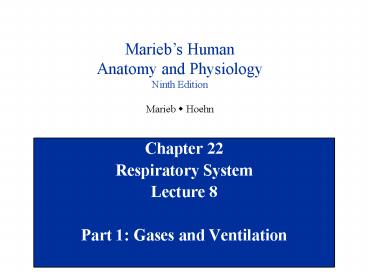Respiratory System - PowerPoint PPT Presentation
Title:
Respiratory System
Description:
Title: NVCC Bio 212 Subject: Respiratory system Author: Greg Erianne Last modified by: Gregs Desktop Created Date: 1/14/2003 11:26:13 PM Document presentation format – PowerPoint PPT presentation
Number of Views:111
Avg rating:3.0/5.0
Title: Respiratory System
1
Mariebs Human Anatomy and Physiology Ninth
Edition Marieb w Hoehn
- Chapter 22
- Respiratory System
- Lecture 8
- Part 1 Gases and Ventilation
2
Gases and Pressure
- Our atmosphere is composed of several gases and
exerts pressure - 78 N2, 21 O2, 0.4 H2O, 0.04 CO2
- 760 mm Hg, 1 ATM, 29.92 Hg, 15 lbs/in2,1034 cm
H2O - Each gas within the atmosphere exerts a pressure
of its own (partial) pressure, according to its
concentration in the mixture (Daltons Law) - Example Atmosphere is 21 O2, so O2 exerts a
partial pressure of 760 mm Hg. x .21 160 mm
Hg. - Partial pressure of O2 is designated as PO2
3
Air Movements
If volume (of container) increases, pressure
decreases and vice versa Stated mathematically P
? 1/V (Boyles Law)
- Moving the plunger of a syringe causes air to
move in or out - Air movements in and out of the lungs occur in
much the same way
Figure from Saladin, Anatomy Physiology,
McGraw Hill, 2007
4
Lungs at Rest
When lungs are at rest, the pressure on the
inside of the lungs is equal to the pressure on
the outside of the thorax
Figure from Holes Human AP, 12th edition, 2010
Think of pressure differences as difference in
the concentration of gas molecules and use the
rules of diffusion. Higher pressure means higher
concentration (ignoring temperature difference)
5
Normal Inspiration
- Intra-alveolar (intrapulmonary) pressure
decreases to about 758 mm Hg as the thoracic
cavity enlarges - Atmospheric pressure (now higher than that in
lungs) forces air into the airways - Compliance ease with which lungs can expand
An active process
Figure from Holes Human AP, 12th edition, 2010
Phrenic nerves of the cervical plexus stimulate
diphragm to contract and move downward and
external (inspiratory) intercostal muscles
contract, expanding the thoracic cavity and
reducing intrapulmonary pressure. Attachment of
parietal pleura to thoracic wall (negative
pressure) pulls visceral pleura, and lungs follow.
6
Maximal (Forced) Inspiration
Thorax during normal inspiration
- Thorax during maximal inspiration
- aided by contraction of sternocleidomastoid and
pectoralis minor muscles
Compliance decreases as lung volume
increases Costal (shallow) breathing vs.
diaphragmatic (deep) breathing
Figure from Holes Human AP, 12th edition, 2010
7
Normal Expiration
- due to elastic recoil of the lung tissues and
abdominal organs - a PASSIVE process (no muscle contractions
involved)
Normal expiration is caused by - elastic recoil
of the lungs (elastic rebound) and abdominal
organs - surface tension between walls of
alveoli (what keeps them from collapsing
completely?)
Figure from Holes Human AP, 12th edition, 2010
8
Maximal (Forced) Expiration
Figure from Holes Human AP, 12th edition, 2010
- contraction of abdominal wall muscles
- contraction of posterior (expiratory) internal
intercostal muscles - An active, NOT passive, process
9
Terms Describing Respiratory Rate
- Eupnea quiet (resting) breathing
- Apnea suspension of breathing
- Hyperpnea forced/deep breathing
- Dyspnea difficult/labored breathing
- Tachypnea rapid breathing
- Bradypnea slow breathing
Know these
10
Nonrespiratory Air Movements
- coughing sends blast of air through glottis
and clears upper respiratory tract - sneezing forcefully expels air through the
nose and mouth - laughing deep breath released in a series of
short convulsive expirations - crying physiologically same as laughing
- hiccupping spasmodic contraction of diaphragm
against closed glottis - yawning deep inspiration through open mouth
- valsalva maneuver expiration against a closed
glottis
11
Alveoli and Respiratory Membrane
- consists of the walls of the alveolus and the
capillary, and the basement membrane between
them
Figure from Holes Human AP, 12th edition, 2010
Surfactant resists the tendency of alveoli to
collapse on themselves.
12
Blood Flow Through Alveoli
Mechanisms that prevent alveoli from filling with
fluid
- cells of alveolar wall are tightly joined
together - the relatively high osmotic pressure of the
interstitial fluid draws water out of them - there is low (hydrostatic) pressure in the
pulmonary circuit
Low pressure circuit
Figure from Holes Human AP, 12th edition, 2010
13
Review
- The atmosphere is composed of a mixture of gases
- Each gas exerts a partial pressure (Pg)
- Sum of all partial pressures atmospheric
pressure (14.7 lbs/in2,760 mm Hg., ) - Gases move from a higher concentration (pressure)
to a lower concentration (pressure) - Function of the diaphragm is to create a lower
intrpulmonary pressure so that atmospheric gases
flow into the lungs
14
Review
- Normal inspiration
- An active process
- Phrenic nerve and diaphragm
- External (inspiratory) intercostal muscles
- Role of the lung pleura
- Normal expiration
- A PASSIVE process
- Due to elasticity of lung/abdominal organs and
alveolar surface tension - Forced inspiration
- Forced expiration
15
Review
- The respiratory membrane
- Simple squamous epithelium of the alveoli and
capillaries - Basement membrane between them
- Terms used to describe breathing (know these)

